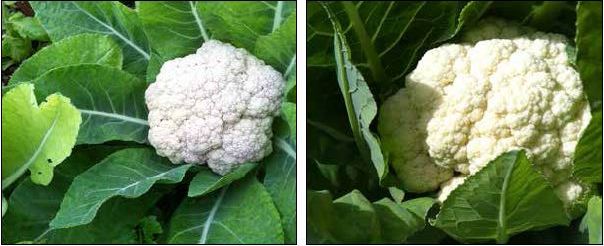CAULIFLOWER
pH: 6.0-6.5
Plant spacing: 45-60 cm (3-5 plants/m2)
Germination time and temperature: 4-7 days with temperature 8-20 °C
Growth time: 2-3 months (spring crops), 3-4 months (autumn crops)
Temperature: 20-25 °C for initial vegetative growth, 10-15 °C for head setting (autumn crop)
Light exposure: full sun
Plant height and width: 40-60 cm; 60-70 cm
Recommended aquaponic method: media beds

Growing cauliflower in aquaponic units: Cauliflower is a high-value, nutritious winter crop that will grow and thrive in media bed units with adequate plant spacing. Cauliflower has a relatively high nutrient demand, and the plants react positively to high concentrations of nitrogen and phosphorus. Among other nutrients, potassium and calcium are important for the production of heads. The plant is particularly sensitive to climatic conditions, and the heads do not develop properly in hot, very cold or very dry conditions; therefore, selecting the suitable variety and the timing to transplant are crucial.
Growing conditions: Optimal air temperature for the initial vegetative growth of the plant is 15-25 °C. For the formation of the heads, the plants require colder temperatures of 10-15 °C (autumn crop) or 15-20 °C (spring crop) providing that a good percentage of relative humidity and full sun conditions are met to develop good heads. Plants can tolerate cold temperatures; however, heads can be damaged by frost. Light shade can be beneficial in warmer temperatures (above 23 °C).
Growing instructions: Germinate seeds in propagation trays at 20-25 °C. Provide direct sun from early seedling stages so plants do not become leggy. When plants are 3-5 weeks old and have 4-5 true leaves, begin transplanting into the aquaponic system about 50 cm apart. To preserve the white colour of the heads, use string or rubber bands to secure outside leaves over the head when it is about 6-10 cm in diameter. Once this stage is reached, harvest may take less than a week in ideal temperatures or as long as a month in cooler conditions. Too much sun, heat or nitrogen uptake can cause "ricey" heads where the main flower separates into small, rice-like grains. Temperatures below 12 °C could instead produce "buttoning". Cauliflower is susceptible to some pests including cabbageworms, flea beetle, white maggots (larvae) and cabbage aphids, which can be removed manually or by using other pest management techniques.
Harvesting: Harvest when the heads are compact, white and firm. Cut the heads off the plant with a large knife, and remove the remaining plant and roots from the bed pipe and place into a compost bin.